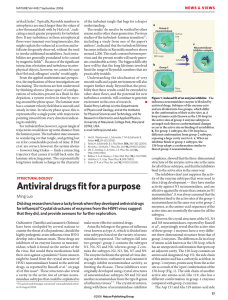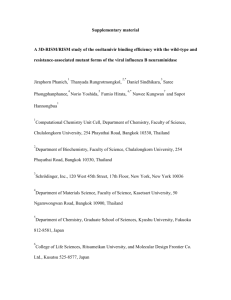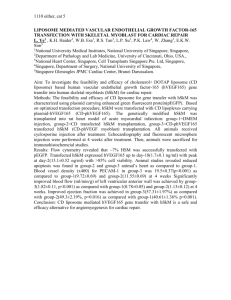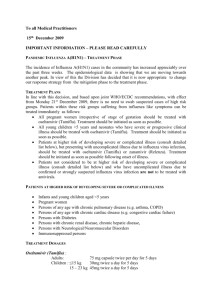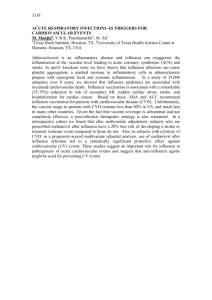The structure of H5N1 avian influenza neuraminidase suggests new
advertisement
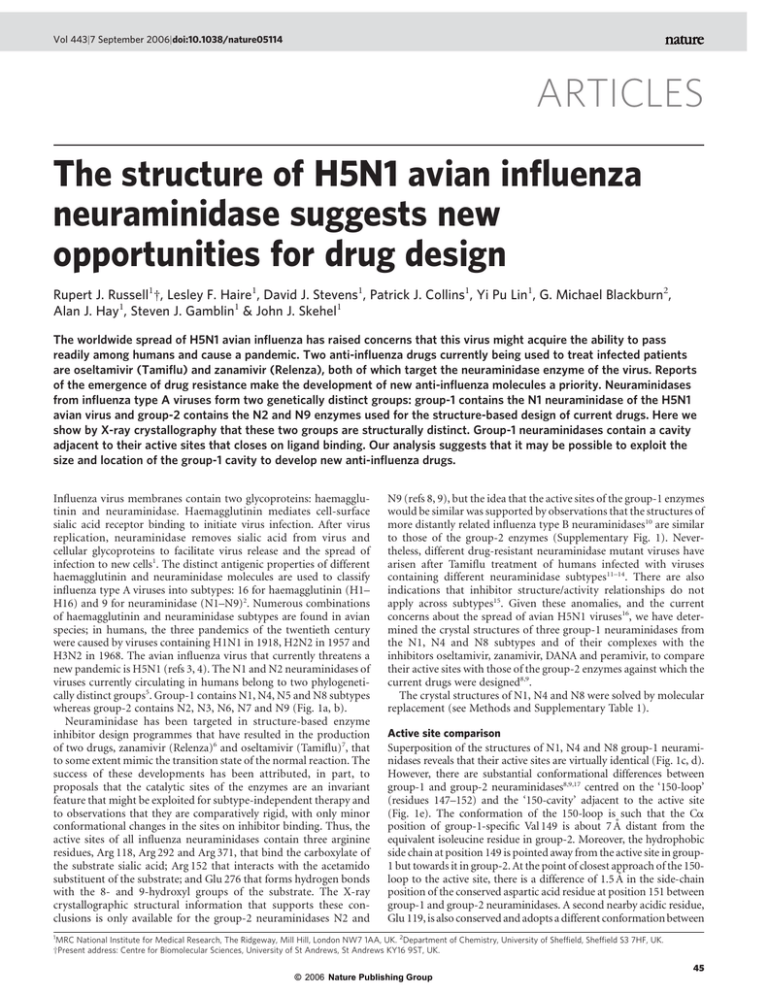
Vol 443|7 September 2006|doi:10.1038/nature05114 ARTICLES The structure of H5N1 avian influenza neuraminidase suggests new opportunities for drug design Rupert J. Russell1†, Lesley F. Haire1, David J. Stevens1, Patrick J. Collins1, Yi Pu Lin1, G. Michael Blackburn2, Alan J. Hay1, Steven J. Gamblin1 & John J. Skehel1 The worldwide spread of H5N1 avian influenza has raised concerns that this virus might acquire the ability to pass readily among humans and cause a pandemic. Two anti-influenza drugs currently being used to treat infected patients are oseltamivir (Tamiflu) and zanamivir (Relenza), both of which target the neuraminidase enzyme of the virus. Reports of the emergence of drug resistance make the development of new anti-influenza molecules a priority. Neuraminidases from influenza type A viruses form two genetically distinct groups: group-1 contains the N1 neuraminidase of the H5N1 avian virus and group-2 contains the N2 and N9 enzymes used for the structure-based design of current drugs. Here we show by X-ray crystallography that these two groups are structurally distinct. Group-1 neuraminidases contain a cavity adjacent to their active sites that closes on ligand binding. Our analysis suggests that it may be possible to exploit the size and location of the group-1 cavity to develop new anti-influenza drugs. Influenza virus membranes contain two glycoproteins: haemagglutinin and neuraminidase. Haemagglutinin mediates cell-surface sialic acid receptor binding to initiate virus infection. After virus replication, neuraminidase removes sialic acid from virus and cellular glycoproteins to facilitate virus release and the spread of infection to new cells1. The distinct antigenic properties of different haemagglutinin and neuraminidase molecules are used to classify influenza type A viruses into subtypes: 16 for haemagglutinin (H1– H16) and 9 for neuraminidase (N1–N9)2. Numerous combinations of haemagglutinin and neuraminidase subtypes are found in avian species; in humans, the three pandemics of the twentieth century were caused by viruses containing H1N1 in 1918, H2N2 in 1957 and H3N2 in 1968. The avian influenza virus that currently threatens a new pandemic is H5N1 (refs 3, 4). The N1 and N2 neuraminidases of viruses currently circulating in humans belong to two phylogenetically distinct groups5. Group-1 contains N1, N4, N5 and N8 subtypes whereas group-2 contains N2, N3, N6, N7 and N9 (Fig. 1a, b). Neuraminidase has been targeted in structure-based enzyme inhibitor design programmes that have resulted in the production of two drugs, zanamivir (Relenza)6 and oseltamivir (Tamiflu)7, that to some extent mimic the transition state of the normal reaction. The success of these developments has been attributed, in part, to proposals that the catalytic sites of the enzymes are an invariant feature that might be exploited for subtype-independent therapy and to observations that they are comparatively rigid, with only minor conformational changes in the sites on inhibitor binding. Thus, the active sites of all influenza neuraminidases contain three arginine residues, Arg 118, Arg 292 and Arg 371, that bind the carboxylate of the substrate sialic acid; Arg 152 that interacts with the acetamido substituent of the substrate; and Glu 276 that forms hydrogen bonds with the 8- and 9-hydroxyl groups of the substrate. The X-ray crystallographic structural information that supports these conclusions is only available for the group-2 neuraminidases N2 and N9 (refs 8, 9), but the idea that the active sites of the group-1 enzymes would be similar was supported by observations that the structures of more distantly related influenza type B neuraminidases10 are similar to those of the group-2 enzymes (Supplementary Fig. 1). Nevertheless, different drug-resistant neuraminidase mutant viruses have arisen after Tamiflu treatment of humans infected with viruses containing different neuraminidase subtypes11–14. There are also indications that inhibitor structure/activity relationships do not apply across subtypes15. Given these anomalies, and the current concerns about the spread of avian H5N1 viruses16, we have determined the crystal structures of three group-1 neuraminidases from the N1, N4 and N8 subtypes and of their complexes with the inhibitors oseltamivir, zanamivir, DANA and peramivir, to compare their active sites with those of the group-2 enzymes against which the current drugs were designed8,9. The crystal structures of N1, N4 and N8 were solved by molecular replacement (see Methods and Supplementary Table 1). Active site comparison Superposition of the structures of N1, N4 and N8 group-1 neuraminidases reveals that their active sites are virtually identical (Fig. 1c, d). However, there are substantial conformational differences between group-1 and group-2 neuraminidases8,9,17 centred on the ‘150-loop’ (residues 147–152) and the ‘150-cavity’ adjacent to the active site (Fig. 1e). The conformation of the 150-loop is such that the Ca position of group-1-specific Val 149 is about 7 Å distant from the equivalent isoleucine residue in group-2. Moreover, the hydrophobic side chain at position 149 is pointed away from the active site in group1 but towards it in group-2. At the point of closest approach of the 150loop to the active site, there is a difference of 1.5 Å in the side-chain position of the conserved aspartic acid residue at position 151 between group-1 and group-2 neuraminidases. A second nearby acidic residue, Glu 119, is also conserved and adopts a different conformation between 1 MRC National Institute for Medical Research, The Ridgeway, Mill Hill, London NW7 1AA, UK. 2Department of Chemistry, University of Sheffield, Sheffield S3 7HF, UK. †Present address: Centre for Biomolecular Sciences, University of St Andrews, St Andrews KY16 9ST, UK. © 2006 Nature Publishing Group 45 ARTICLES NATURE|Vol 443|7 September 2006 the two groups. In group-2 structures this residue forms a hydrogen bond with Arg 156 but in group-1 it adopts a conformation such that its carboxylate points in approximately the opposite direction (Fig. 1e). However, comparison of the amino acid residues in the 150-loops offers no obvious explanation for the strong conservation of loop structure within, but not between, group-1 and group-2. A major consequence of these differences in structure is that there is a large cavity adjacent to the active site in group-1 but not in group2 neuraminidases (Fig. 2). This cavity is accessible from the active site because of the differences in position of Asp 151 and Glu 119 described above. The combined effect of the difference in position of these two acidic residues is to increase the width of the active site cavity by about 5 Å. The conserved Arg 156, the side chain of which is located approximately mid-way between the two acidic residues, adopts approximately the same position in the group-1 and group-2 structures and defines the entrance from the active site cavity into the 150-cavity. The extent of the 150-cavity is then determined by the difference in conformation of the 150-loop and by the position of Gln 136 (Fig. 2). In group-2 proteins this residue forms a hydrogen bond with the main-chain carbonyl of residue 150 of the loop. In group-1 structures, presumably as a consequence of the different loop structure, Gln 136, unable to make this hydrogen bond, adopts a conformation that results in its side chain sitting about 3.5 Å lower at the base of the cavity. The 150-cavity is therefore about 10 Å long and 5 Å wide and deep (Fig. 2). The conformation of the active site residue Glu 276 has been of particular interest because it undergoes a marked rearrangement on Figure 1 | Genetic and structural relationships between neuraminidases from different influenza viruses. a, Phylogenetic tree containing representative neuraminidases of influenza B and the nine subtypes of neuraminidase from influenza A. Influenza A neuraminidases fall into two distinct groups, which we have called group-1 and group-2 and coloured in green and yellow, respectively; the neuraminidase from influenza B is shown in blue. (Where appropriate, this colouring scheme is used in subsequent figures.) b, Table showing statistics for the similarities of sequence and structures between two members of group-1 (N1 and N8) and two from group-2 (N2 and N9) of influenza A with the neuraminidase from influenza B. The percentage sequence identities are shown on the left-hand side and root mean square deviations of Ca positions between monomers is given on the right-hand side. 46 drug binding to neuraminidases from influenza B and group-2. For example, in unliganded group-2 (N9) the carboxylate of Glu 276 faces into the active site, but on oseltamivir binding it adopts a conformation pointing away from the active site so that the carboxylate now makes a bidentate interaction with the guanidinium group of Arg 224 (ref. 7). In the unliganded N1 (group-1) structure the conformation of Glu 276 (Fig. 1e) is very similar to that seen in unliganded N9 and, as we shall describe later, it undergoes a very similar rearrangement to that in N9 on oseltamivir binding. Group-1 neuraminidase binding to inhibitors We have determined the crystal structures of known anti-neuraminidase inhibitors in complex with N1, N4 and N8 (see Supplementary Table 1). Notably, we find that group-1 neuraminidases can bind oseltamivir in either the ‘open’ or ‘closed’ conformation of the 150loop, depending on the soaking conditions. Thus, the structure of N8 neuraminidase in complex with oseltamivir, resulting from a 30-min soak of inhibitor into preformed crystals, reveals that no large-scale conformational changes have occurred (Fig. 3a) and that the 150loop retains the same conformation as in the unliganded structure. Presumably as a consequence of the conformation of the 150-loop the acidic residues Asp 151 and Glu 119 are located further from the nitrogen attached to C4 of the inhibitor than they are in the complex with N9. Other interactions between oseltamivir and the N8 neuraminidase are similar to those observed in N9, with the further exception that Tyr 347 makes a hydrogen bond interaction with the C1 carboxylate of oseltamivir (Fig. 2) in addition to the usual There is a strong correlation between the extent of sequence identity and the similarity of the crystal structures. c, Ribbons representation of the group-1 (N1) neuraminidase tetramer. One monomer is coloured to emphasize the molecules’ canonical six-bladed b-propeller structure. The active site region at the centre of the six-bladed b-propeller structure is highlighted and then shown on a larger scale in d and e. d, Superposition of the active sites of three neuraminidases from group-1, showing how similar they are: N1, green; N4, gold; and N8, blue. e, Superposition of the active site of N1 (green) and N9 (yellow) neuraminidases, demonstrating that N9 is markedly different to N1 in the 150-loop region. Conserved residues such as Glu 119, Asp 151 and Glu 276 and the hydrophobic residue at position 149 are shown in stick representation. © 2006 Nature Publishing Group ARTICLES NATURE|Vol 443|7 September 2006 bidentate interaction of that carboxylate with Arg 371. In group-2 neuraminidases, residue 347 is a glutamine, rather than a tyrosine, which is unable to make such a hydrogen bond. It seems likely that the binding of oseltamivir to N8, at least in the crystalline state, is a two-step process. First, inhibitor binds to the ‘open’ form of N8 and then a slow conformational change occurs that results in the ‘closed’ form of the enzyme that is able to make a tighter interaction with ligand. At this stage we have no information about how the slow conformational change that occurs in the crystalline state relates to the enzyme in solution, but our structural observations show that this type of inhibitor is capable of binding to the open conformation of group-1 neuraminidases. Incubating N1 crystals in 20 mM oseltamivir for 150 min also showed binding of inhibitor with the 150-loop in the open cavity conformation (Supplementary Fig. 2), but when N8 crystals were incubated in oseltamivir for 3 days (Fig. 3a, b), or N1 crystals were incubated in a higher concentration of inhibitor (Fig. 3b), the 150loop changes its conformation so that it closely resembles the conformation observed in group-2 neuraminidases in the presence and absence of inhibitors. There are two main consequences of this change in conformation. First, Glu 119 and Asp 151 are now both oriented towards the bound oseltamivir, and second, the size of the active site cavity in drug-bound group-1 is now much the same as it is for group-2 neuraminidases. We have also determined the structures of three other neuraminidase inhibitors, DANA6,18,19, zanamivir20 and peramivir21, bound to group-1 neuraminidases (Supplementary Fig. 3). These structures show that the drug-bound complexes of group-1 are very similar to those seen for group-2 neuraminidases. Overall, the observation of the open conformation for the 150loop in the group-1 structures suggests that, for these enzymes, this conformation of the loop is intrinsically lower in energy than the closed conformation. Group-1 neuraminidases (N1 and N8) initially bind to oseltamivir in this open conformation but eventually adopt the closed conformation. It thus seems that oseltamivir binding to group-1 neuraminidases favours the higher energy or closed conformation of the 150-loop that it probably accesses via a relatively slow conformational change. It should therefore be possible to design new inhibitors for group-1 neuraminidases that are selective for the open 150-loop conformation and would thereby have the potential to bind more strongly than oseltamivir or zanamivir. Examination of the structures suggests, for example, that it may be possible for a new substituent to be developed from the 4-amino group of oseltamivir into the 150-cavity and thereby enhance the binding of potential inhibitors. The prominent guanidinium side chain of conserved Arg 156, at the base of the 150-cavity (Fig. 2), is Figure 2 | Molecular surfaces of group-1 and group-2 neuraminidases with bound oseltamivir showing the 150-cavity in the group-1 structure that arises because of the distinct conformation of the 150-loop. a, b, N1 (a; green) and N9 (b; yellow) shown in surface representation with the protein main chain shown in ‘worm’ representation. c, Superposition of the active sites of apo-N1 (green) and N1 complexed with oseltamivir (blue). Part of the electron density map from a low-resolution (5.5 Å) difference Fourier calculated between apo-N1 and oseltamivir-bound N1 data sets is shown in blue to indicate the position of the 150-cavity. Figure 3 | Oseltamivir binding to the active sites of group-1 neuraminidases. a, Superposition of the active sites of N8 after a 30-min soak (dark blue) and a 3-day soak (cyan) with 20 mM oseltamivir. There are small changes in the position of Glu 119 and the inhibitor when the 150-loop closes after the longer soaking time. b, Superposition of the active sites of N8 with bound oseltamivir after the 3-day soak with 20 mM inhibitor (cyan) with N1 soaked for 30 min in 0.5 mM inhibitor (green). In this case, the structures of the two different subtypes of neuraminidase from group-1 are remarkably similar. © 2006 Nature Publishing Group 47 ARTICLES NATURE|Vol 443|7 September 2006 clearly a prospective partner for a salt-bridge or hydrogen bond with a new inhibitor. Differential oseltamivir resistance of mutant neuraminidases Three principal oseltamivir-resistant mutant neuraminidases have been characterized from influenza A viruses isolated after Tamiflu treatment of influenza-infected humans14,22. One, derived from H1N1 and H5N1 infections, contained the amino acid substitution His274Tyr. The other two were from patients infected with H3N2 viruses and contained either Arg292Lys or, less frequently, Glu119Val substitutions. Although oriented differently in unliganded group-1 compared with group-2 neuraminidases, Glu 119 of both groups appears to interact similarly with oseltamivir. Comparison of the structures of group-1 and group-2 neuraminidases reveals groupspecific differences in the active sites that might explain how the mutations at positions 274 and 292 lead to inhibitor resistance. The mutation His274Tyr leads to high resistance of group-1 neuraminidases against oseltamivir but has little effect on group-2 neuraminidases23,24. Inspection of the structures of the group-1 neuraminidases in complex with oseltamivir, and comparison with equivalent group-2 complexes, suggests a reason for this groupspecific difference and indicates how resistance may be mediated by Figure 4 | Locations of the oseltamivir resistance mutations found in group-1 and group-2 neuraminidases. Middle panel: superposition of the active sites of group-1 (green) and group-2 (yellow) neuraminidases with bound oseltamivir; two regions of the active site are highlighted and detailed in the top and bottom panels. Top panel: residues involved in the group-2specific resistance mutant Arg292Lys also showing that residue 347 is a tyrosine residue in the group-1 protein but an asparagine in group-2. Bottom panel: residues involved in the group-1-specific resistance mutant His274Tyr showing that the tyrosine at position 252 is involved in a network of hydrogen bonds in group-1. 48 the effects of the mutant Tyr 274 on the orientation of Glu 276. The importance of the conformation of Glu 276 for oseltamivir binding by group-2 neuraminidases has been firmly established25. There seems to be at least two factors contributing to the inability of group-1 neuraminidases to accommodate the His274Tyr substitution (Fig. 4). First, the 270-loop in group-1 neuraminidases approaching residue 273 makes a tighter turn than the equivalent loop in group-2. Second, in group-1 neuraminidases, but not in group-2, there is a conserved tyrosine residue at position 252 that makes hydrogen bonds to the main-chain carbonyl at position 273, to the peptide amide at 250 and to the histidine side chain at 274. Histidine 274 also forms a hydrogen bond through its other sidechain nitrogen with Glu 276. It appears that introduction of the bulkier tyrosine residue at position 274 in group-1 (N1) enzymes can only be accommodated by the new side chain moving towards, and partially displacing, Glu 276. By contrast, in group-2 enzymes, there is a smaller residue at position 252, leaving space for Tyr 274 to occupy without perturbing Glu 276. This interpretation of the group-specific effect of this mutation is consistent with observations from mutagenic studies that examined the effects of side-chain size at residue 274 on sensitivity to oseltamivir23. The mutation Arg292Lys is the commonest substitution in group2 (N2) neuraminidases resistant to oseltamivir22. It has already been the subject of a detailed crystallographic analysis to show that in the group-2 neuraminidase N9, resistance results, in part, from the loss of a hydrogen bond from Arg 292 to the carboxylate group of oseltamivir25. The substituted Lys 292 also interacts with Glu 276, impeding its movement to accommodate the hydrophobic substituent attached to C6 of oseltamivir. The structures of group-1 neuraminidases, and their complexes with oseltamivir, now reveal a likely reason for the smaller effect of the mutation on group-1 enzymes. As Fig. 4 shows, the conserved tyrosine residue at position 347 in the group-1 neuraminidase N1 makes an additional hydrogen bond to the carboxylate group of the inhibitor that cannot be made by the equivalent residues in group-2 neuraminidases. In this way it seems that the additional hydrogen bond interaction between Tyr 347 and the carboxylate of the inhibitor compensates for a weaker, watermediated interaction between the carboxylate and the substituted lysine residue at position 292 (ref. 25). Conclusion As a proven anti-influenza drug target, neuraminidase continues to be attractive for the development of new virus inhibitors, not least because of the emergence of viruses resistant to the currently available drugs14,26–28. The crystal structures of group-1 neuraminidases described here will add to this attraction. They show that the 150-loop, which forms one corner of the enzyme active site, is able to exist in at least two stable conformations. The fact that group-1 neuraminidases bind drugs like oseltamivir with similar affinity to group-2 enzymes22 suggests that the difference in energy between the two conformations is not very large. The notion of a degree of plasticity in the structure of the active site of neuraminidase, or at least of the group-1 enzymes, is unexpected, but considering their similarities in sequence it would not now be surprising if the 150loop of group-2 neuraminidases was found to also possess a degree of flexibility. Evidently the closed conformation is energetically preferred in group-2 neuraminidases, both in the absence and presence of current inhibitors, but a higher energy open conformation may well be accessible to an inhibitor that could make an energetically advantageous interaction with it. On the basis of our structural observations, new drugs against group-1 neuraminidases could be obtained by adding extra substituent moieties to existing inhibitor skeletons. Although it may be considered ideal to focus on compounds that work against all virus subtypes, an effective group-specific inhibitor could be of considerable value against the currently circulating human H1N1 viruses, the H3N8 viruses that repeatedly cause influenza in equines and are now © 2006 Nature Publishing Group ARTICLES NATURE|Vol 443|7 September 2006 causing widespread disease in canines29, and the avian H5N1 viruses that currently threaten the human population. In any case, it may well be possible that new inhibitors designed to exploit additional interactions with the open form of the 150-loop of group-1 neuraminidases could select a similar conformation of this loop in group2 neuraminidases. METHODS N1 neuraminidase (NA) was prepared from a WSN-NA (H5N1) recombinant virus containing seven genes from WSN and the neuraminidase gene from A/ Vietnam/1203/04. N4 and N8 neuraminidases from A/mink/Sweden/E12665/84 (H10N4) and A/duck/Ukraine/1/63 (H3N8) were prepared from viruses grown in hens’ eggs. Neuraminidase was released from the viruses by bromelain digestion, and further purified, as previously described30. N1 crystals were grown by vapour diffusion in sitting drops dispensed by an Oryx-6 crystallization robot from Douglas Instruments. A total of 0.1 ml of protein solution, at 9 mg ml21 in 10 mM Tris-HCl, pH 8.0, was mixed with an equal volume of reservoir solution (0.1 M MES, pH 6.0, 0.2 M ammonium acetate, 20% w/v PEG 3350). N4 crystals were grown by vapour diffusion in hanging drops consisting of 2 ml of reservoir solution (0.1 M HEPES, pH 7.5, 5 mM cobalt chloride, 5 mM nickel chloride, 5 mM cadmium chloride, 5 mM magnesium chloride and 12% w/v PEG 3350) and 2 ml of concentrated protein solution (10 mg ml21 in 10 mM Tris-HCl, pH 8.0). N8 neuraminidase crystals were grown by vapour diffusion in hanging drops consisting of 2 ml of reservoir solution (0.1 M imidazole, pH 8.0 and 35% MPD) and 2 ml of concentrated protein solution (10 mg ml21 in 10 mM Tris-HCl, pH 8.0). Crystals of N4 and N8 were soaked for 30 min in inhibitor made up in crystallization buffer (augmented with 20% glycerol, in the case of N4, for cryo-protection) at concentrations of 20 mM for oseltamivir, zanamivir and peramivir and at 20 mM for DANA. Additionally, a crystal of N8 neuraminidase was soaked in 20 mM oseltamivir for 3 days. N1 was cryo-protected by the addition of 15% v/v ethylene glycol and the oseltamivir soaks were carried out using 20 mM or 0.5 mM drug made up in this cryo-protectant. N4 and N8 data were collected at 100 K on an in-house Rigaku-MSC RU200 rotating anode coupled to a RaxisIIc detector. N1 data sets were recorded on a Raxis4 detector (100-mm scan) mounted on a Rigaku MicroMax 007 HF generator. Diffraction data were integrated using Denzo and scaled with Scalepack31. N1, N4 and N8 neuraminidase structures were solved by molecular replacement using variously AmoRe (N1) and Phaser32 (N4, N8) with N9 neuraminidase as the initial search model. Standard refinement was carried out with a combination of refmac532 and CNS33 together with manual model building with O34. Figures were created with Pymol (http://pymol.sourceforge.net/). Received 6 June; accepted 25 July 2006. Published online 16 August 2006. 1. Murphy, B. R. & Webster, R. G. in Fields Virology 3rd edn (eds Fields, D. B. N., Knipe, M. & Howley, P. M.) 1397–-1445 (Lippincott-Raven, Philadelphia, 1996). 2. World Health Organization. A revision of the system of nomenclature for influenza viruses: a WHO memorandum. Bull. World Health Organ. 58, 585–-591 (1980). 3. Bender, C. et al. Characterization of the surface proteins of influenza A (H5N1) viruses isolated from humans in 1997–-1998. Virology 254, 115–-123 (1999). 4. World Health Organization Global Influenza Program Surveillance Network. Evolution of H5N1 avian influenza viruses in Asia. Emerg. Infect. Dis. 11, 1515–-1521 (2005). 5. Thompson, J. D., Higgins, D. G. & Gibson, T. J. Improved sensitivity of profile searches through the use of sequence weights and gap excision. Comput. Appl. Biosci. 10, 19–-29 (1994). 6. von Itzstein, M. et al. Rational design of potent sialidase-based inhibitors of influenza virus replication. Nature 363, 418–-423 (1993). 7. Kim, C. U. et al. Influenza neuraminidase inhibitors possessing a novel hydrophobic interaction in the enzyme active site: design, synthesis, and structural analysis of carbocyclic sialic acid analogues with potent antiinfluenza activity. J. Am. Chem. Soc. 119, 681–-690 (1997). 8. Varghese, J. N., Laver, W. G. & Colman, P. M. Structure of the influenza virus glycoprotein antigen neuraminidase at 2.9 Å resolution. Nature 303, 35–-40 (1983). 9. Baker, A. T., Varghese, J. N., Laver, W. G., Air, G. M. & Colman, P. M. Threedimensional structure of neuraminidase of subtype N9 from an avian influenza virus. Proteins 2, 111–-117 (1987). 10. Burmeister, W. P., Ruigrok, R. W. & Cusack, S. The 2.2 Å resolution crystal structure of influenza B neuraminidase and its complex with sialic acid. EMBO J. 11, 49–-56 (1992). 11. Ives, J. et al. Anti-viral drug resistance: an oseltamivir treatment-selected influenza A/N2 virus with a R292K mutation in the neuraminidase gene has reduced infectivity in vivo. J. Clin. Virol. 18, 251–-269 (2000). 12. Gubareva, L. V., Kaiser, L., Matrosovich, M. N., Soo-Hoo, Y. & Hayden, F. G. Selection of influenza virus mutants in experimentally infected volunteers treated with oseltamivir. J. Infect. Dis. 183, 523–-531 (2001). 13. Carr, J. et al. Influenza virus carrying neuraminidase with reduced sensitivity to oseltamivir carboxylate has altered properties in vitro and is compromised for infectivity and replicative ability in vivo. Antiviral Res. 54, 79–-88 (2002). 14. Ward, P., Small, I., Smith, J., Suter, P. & Dutkowski, R. Oseltamivir (Tamiflu) and its potential for use in the event of an influenza pandemic. J. Antimicrob. Chemother. 55 (suppl. 1), i5–-i21 (2005). 15. Brouillette, W. J. et al. Pyrrolidinobenzoic acid inhibitors of influenza virus neuraminidase: modifications of essential pyrrolidinone ring substituents. Bioorg. Med. Chem. 11, 2739–-2749 (2003). 16. Webster, R. G., Peiris, M., Chen, H. & Guan, Y. H5N1 outbreaks and enzootic influenza. Emerg. Infect. Dis. 12, 3–-8 (2006). 17. Colman, P. M., Varghese, J. N. & Laver, W. G. Structure of the catalytic and antigenic sites in influenza virus neuraminidase. Nature 303, 41–-44 (1983). 18. Bossart-Whitaker, P. et al. Three-dimensional structure of influenza A N9 neuraminidase and its complex with the inhibitor 2-deoxy 2,3-dehydro-Nacetyl neuraminic acid. J. Mol. Biol. 232, 1069–-1083 (1993). 19. Burmeister, W. P., Henrissat, B., Bosso, C., Cusack, S. & Ruigrok, R. W. Influenza B virus neuraminidase can synthesize its own inhibitor. Structure 1, 19–-26 (1993). 20. Meindl, P., Bodo, G., Palese, P., Schulman, J. & Tuppy, H. Inhibition of neuraminidase activity by derivatives of 2-deoxy-2,3-dehydro-Nacetylneuraminic acid. Virology 58, 457–-463 (1974). 21. Babu, Y. S. et al. BCX-1812 (RWJ-270201): discovery of a novel, highly potent, orally active, and selective influenza neuraminidase inhibitor through structurebased drug design. J. Med. Chem. 43, 3482–-3486 (2000). 22. Mishin, V. P., Hayden, F. G. & Gubareva, L. V. Susceptibilities of antiviralresistant influenza viruses to novel neuraminidase inhibitors. Antimicrob. Agents Chemother. 49, 4515–-4520 (2005). 23. Wang, M. Z., Tai, C. Y. & Mendel, D. B. Mechanism by which mutations at His 274 alter sensitivity of influenza A virus N1 neuraminidase to oseltamivir carboxylate and zanamivir. Antimicrob. Agents Chemother. 46, 3809–-3816 (2002). 24. Yen, H. L. et al. Neuraminidase inhibitor-resistant influenza viruses may differ substantially in fitness and transmissibility. Antimicrob. Agents Chemother. 49, 4075–-4084 (2005). 25. Varghese, J. N. et al. Drug design against a shifting target: a structural basis for resistance to inhibitors in a variant of influenza virus neuraminidase. Structure 6, 735–-746 (1998). 26. Le, Q. M. et al. Avian flu: isolation of drug-resistant H5N1 virus. Nature 437, 1108 (2005). 27. Kiso, M. et al. Resistant influenza A viruses in children treated with oseltamivir: descriptive study. Lancet 364, 759–-765 (2004). 28. de Jong, M. D. et al. Oseltamivir resistance during treatment of influenza A (H5N1) infection. N. Engl. J. Med. 353, 2667–-2672 (2005). 29. Crawford, P. C. et al. Transmission of equine influenza virus to dogs. Science 310, 482–-485 (2005). 30. Ha, Y., Stevens, D. J., Skehel, J. J. & Wiley, D. C. X-ray structures of H5 avian and H9 swine influenza virus hemagglutinins bound to avian and human receptor analogs. Proc. Natl Acad. Sci. USA 98, 11181–-11186 (2001). 31. Otwinowski, Z. & Minor, W. in Data Collection and Processing (eds Sawyer, L., Isaacs, N. & Bailey, S.) 556–-562 (SERC Daresbury Laboratory, Warrington, 1993). 32. CCP4. The CCP4 suite: programs for protein crystallography. Acta Crystallogr D 50, 760–-763 (1994). 33. Brunger, A. T. et al. Crystallography & NMR system: a new software suite for macromolecular structure determination. Acta Crystallogr. D 54, 905–-921 (1998). 34. Jones, T. A., Zhou, J. Y., Cowan, S. W. & Kjeldgaard, M. Improved methods for building protein models in electron density maps and the location of errors in these models. Acta Crystallogr. A 47, 110–-119 (1991). Supplementary Information is linked to the online version of the paper at www.nature.com/nature. Acknowledgements This work was supported by the MRC (UK) and by an International Partnership Research Award in Veterinary Epidemiology from the Wellcome Trust. R.J.R. acknowledges the Wellcome Trust and the University of St Andrews for support and Biocryst for supply of peramivir. We thank P. Walker for assistance with data collection and preparation of the manuscript, and Rigaku (Europe) and CRUK (Lincoln’s Inn) for access to data collection facilities. Author Information Coordinates have been deposited with the Protein Data Bank and the relevant accession codes (2HTY, 2HU0, 2HU4, 2HT5, 2HTR, 2HT7, 2HT8, 2HTQ, 2HTU, 2HTV and 2HTW) are described in Supplementary Table 1. Reprints and permissions information is available at www.nature.com/ reprints. The authors declare no competing financial interests. Correspondence and requests for materials should be addressed to J.J.S. (mbrenna@nimr.mrc.ac.uk). © 2006 Nature Publishing Group 49
